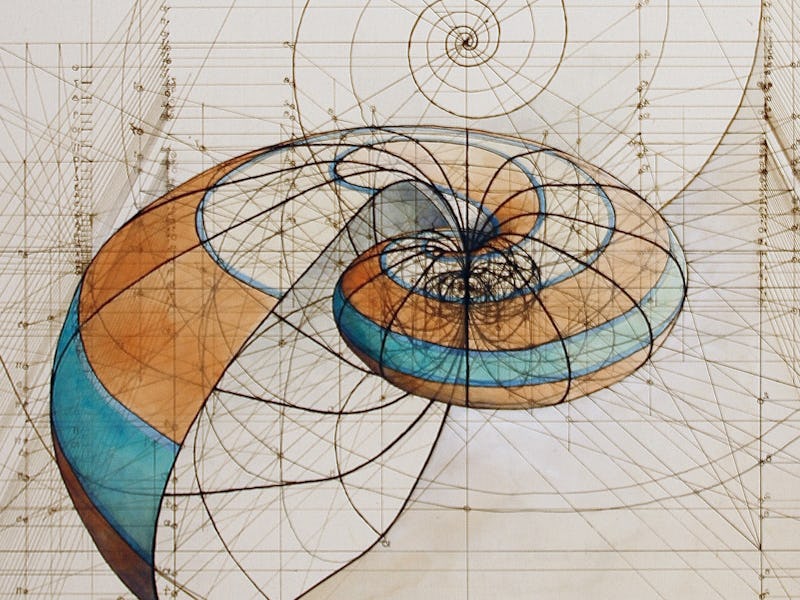Rafael Araujo Draws Perfect Illustrations by Hand Using Math's Golden Ratio
No computer programs necessary.

When artist and architect Rafael Araujo needs inspiration to create a new illustration, all he has to do is look out the window of his studio in Caracas, Venezuela. He can instantly spot what he describes as intelligent patterns — spirals and gentle curves in rocks, flower petals, leaves, shells, insect formations, and other objects in nature.
“In a similar way a geologist sees patterns in rocks, I see them in nature as a whole,” Araujo tells Inverse.
His fascination with these patterns has led to a 40 year career of drawing super precise 3D illustrations that he creates by hand, without any assistance from computers. And the illustrations in his “Calculation” series are incredibly detailed and gorgeous — they’ve even been compared to Da Vinci’s sketches. To get such accurate, photo-perfect renderings of nature, he uses the mathematical proportion known as the golden ratio — a proportion that comes up in many natural objects and is responsible for the “intelligent patterns” Araujo comes across. “We tend to call it ‘intelligent,’ but perhaps this is just the way life is, with no need of any adjective at all,” says Araujo, who studied architecture at the Simon Bolivar University in Venezuela.
Danaus double helix.
The golden ratio — a pi-like irrational number around 1.6180 — was first given its “golden” title by German mathematician Martin Ohm in 1835. Many believe that the golden ratio exists everywhere. The ratio played a crucial role in Dan Brown’s novel The Da Vinci Code, with the fiction finding it in the human body, the pyramids of Giza, and the Parthenon in Athens.
Dodecahedron.
But to Araujo, the real-life, natural objects that follow the golden ratio are beautiful: “The way a living organism is built, for instance, its symmetry, elegance, beauty,” seems to follow the pattern, he says. He first noticed patterns in his small garden he had when he was 15 years old. He was following the growth sequences of a plant’s leaf and saw that they formed spirals.
“This secret of nature’s beautiful designs unfolded before my very eyes,” Araujo said in a video about his work.
Golden ratio.
The golden ratio is the structural backbone of all his pieces. When he sits down to start one of his 3D illustrations, he first calculates and translates all the numbers into geometric parameters with a drafting board, compass, protractors, rulers, and ink pens. For his spiraling butterflies, for example, he calculates the dimensions, flight path, and proportions of the spiral with a specific equation and connects each point until the whole image is complete. Each object or shape requires its own unique calculations, he explains. “If you change a number or a parameter, you’ll end in another result completely.”
Rotated.
The illustrations in the “Calculation” series have a very distinct style. Araujo chooses to leave in the construction lines to show his process and the mathematical framework of the object. He also uses ink as his medium to draw the entire illustration “out of daring spirit,” he says, and he loves the character it adds as a result. He’ll sometimes color the renderings, but it is a surprisingly difficult step that can tag on a few extra hours to an already lengthy, tedious process. One illustration can easily take up to two weeks if he spends 10 hours a day drawing and calculating.
Mariposa con sombra.
Morpho sequence
“Since it’s all made by hand and being — literally — an equation, I do not have much room for errors,” he says. “Everything must be thoroughly thought before the first line is drawn, because I work in ink from the beginning [of creating an illustration].”
Fibonacci sequence shell.
Now, he hopes to share the beautiful patterns he sees in nature with others through his upcoming coloring book — appropriately titled the Golden Ratio Coloring Book — which he announced in March. Back in October 2015, Araujo paired up with two devoted fans in Sydney and created a Kickstarter to raise the funds to publish the book. The Kickstarter page reads:
We believe this book is special. Not only for Rafael’s wonderful illustrations but because it will enable all of us, regardless of our age, to disconnect from the distractions and hectic pace of our modern lives and reconnect with the calm deep within ourselves and the awesome wonder of the natural world around us.
Metatron's cube.
So far, the Kickstarter has over 7,400 backers and 330,000 dollars raised. The team already developed five prototypes of the book to make sure the printing, binding, and cover represent Araujo’s illustrations well. Araujo picked images that best show the quality, design, theme, and order of complexity of his art.
Because of his artwork, Araujo now has a deep respect for nature: “It makes me regret how inconsiderate we human beings could be in regard with its care and conservation.” Hopefully his coloring book will do the same for others, as Araujo looks forward to showing people the beauty that lies within well-ordered patterns.
“Coloring them should be both a pleasure and a challenge,” he says.
Check out more of Araujo’s nature-inspired illustrations below.
The Golden Ratio Coloring Book.
Blue butterfly spiral.
Golden ratio spiral.
Fibonacci 3 branches II.
Golden sequence.
Water mirror reflection.
Phoebis triple helix.
Spiny shell.
Metatron´s cube.